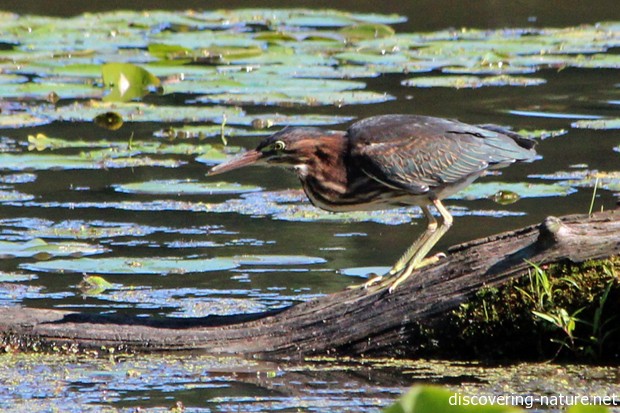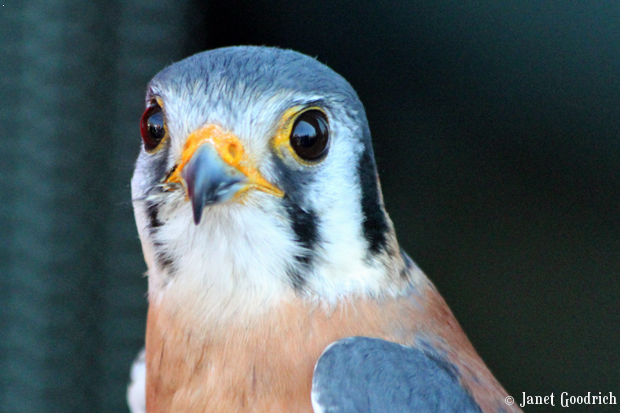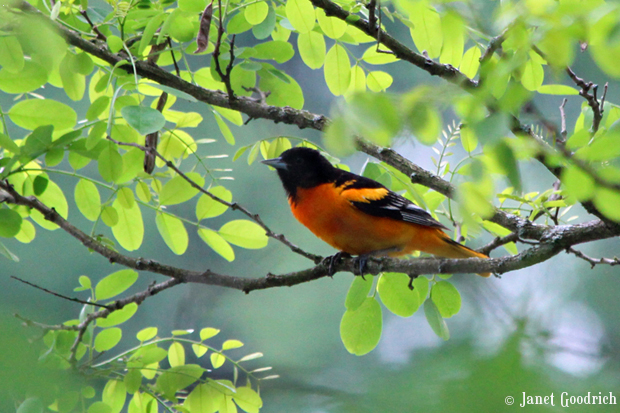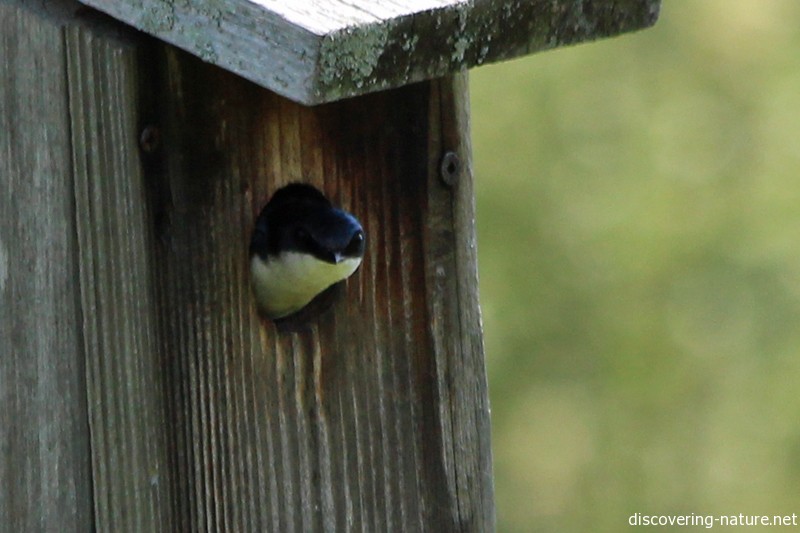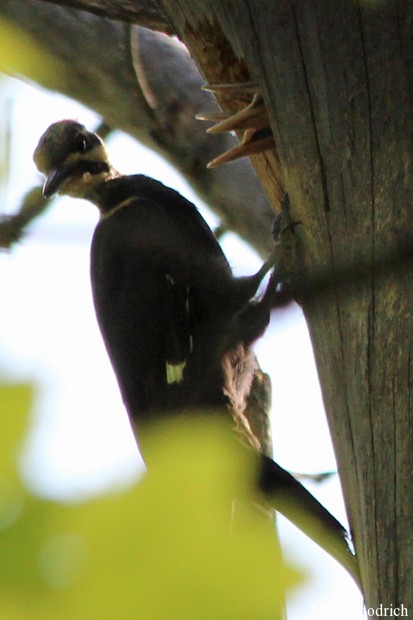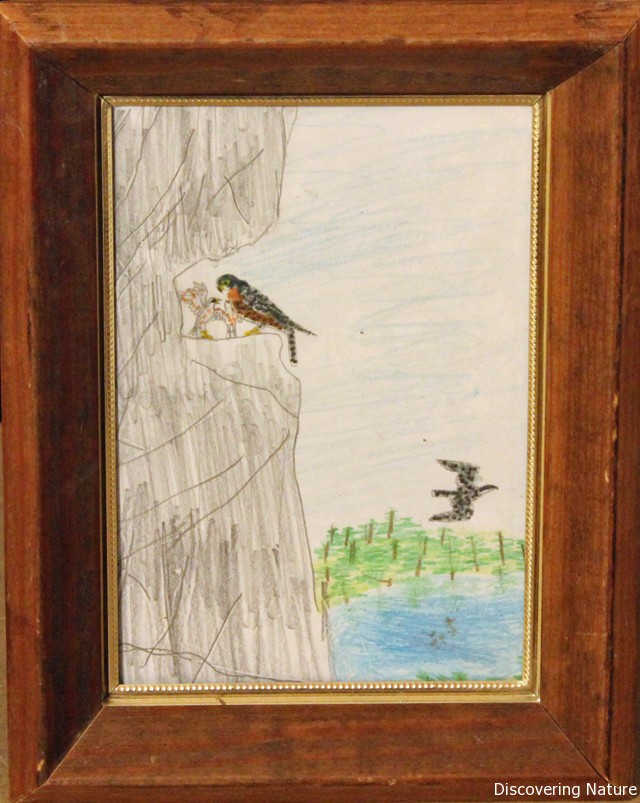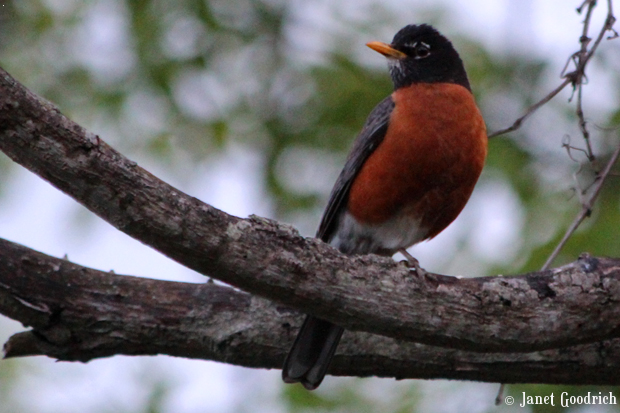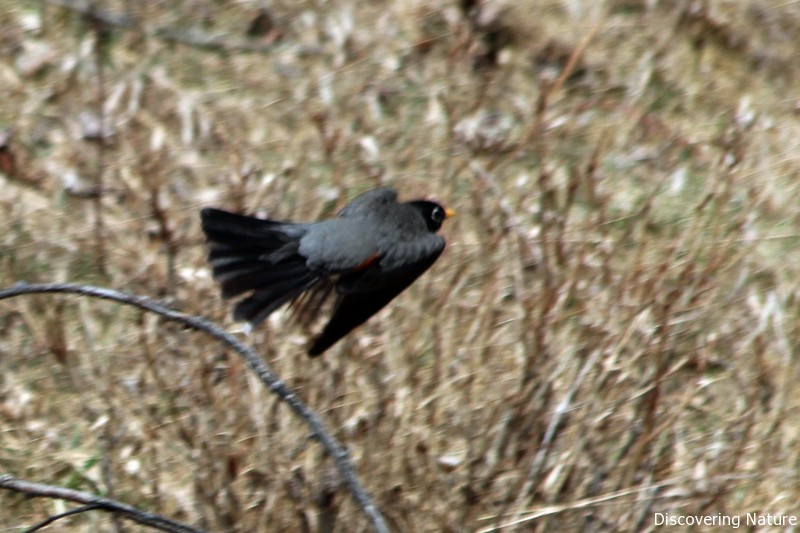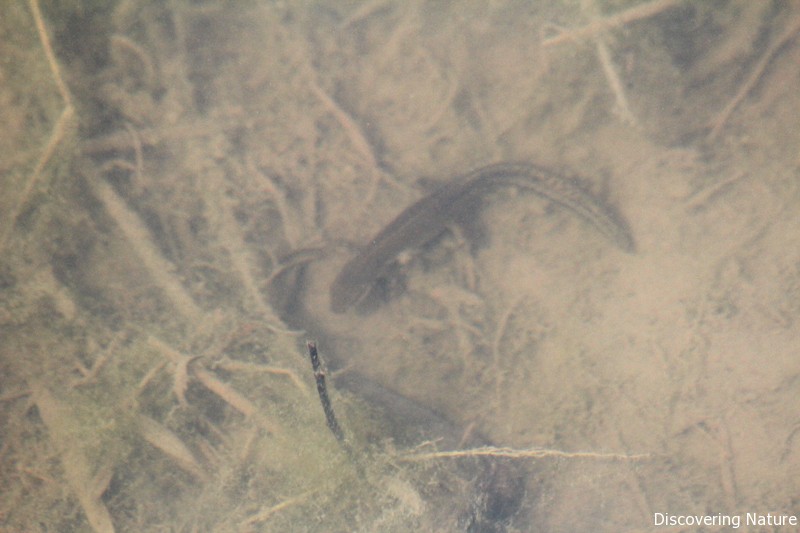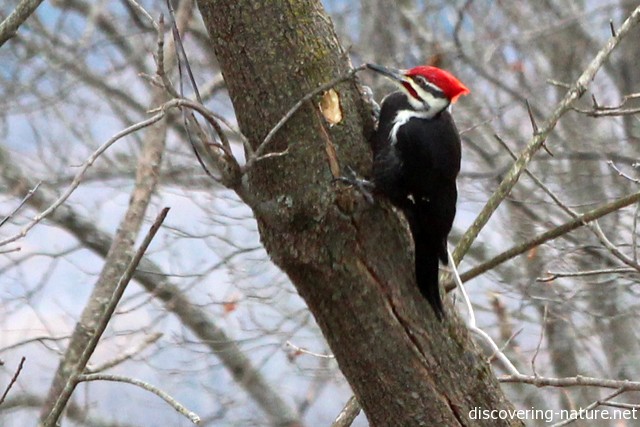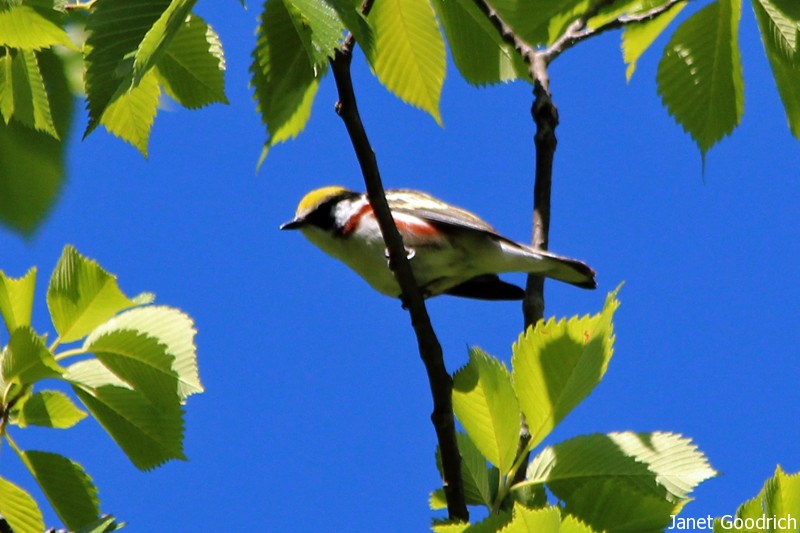Ponds & Streams
-
Green Heron
-
Tanglewood
Sometimes, even the tail end of wildlife can be pretty cute…
…but then, goslings are cute from all angles.
Other things, close-to-the-ground, may require a certain perspective to be seen as “cute.” At the least, they’re indisputably well adapted.
We saw any number of butterflies, including this tiny specimen — which I believe to be an American Copper.
We were not only the observers at the Nature Center we visited today, however. Sometimes, we were the observed.
I think this is a young tree swallow. It didn’t take off the way I’d expect an adult to. It just observed us keenly.
This young oriole was one of a pair of males. They appeared to be getting along equably, then suddenly the mature one chased the immature one off across the field.
I enjoyed the red-winged blackbirds around the pond.
They seem common enough, yet I find them very pleasing to the eye.
One of the first things we saw was a bluebird — our state bird. On our walk we saw any number of chipmunks in the woods, and witnessed a drama between a blue jay and several great crested flycatchers darting and screaming at him until they finally chased him away. We also saw some downy woodpeckers, and lots of evidence of woodpecker carving in the trees. The prize was a sighting of a red-eyed vireo — a bird often heard but rarely seen. It sang right over our heads for a while, pausing only to smash a caterpillar to pulp at one point.
We heard several birds we never saw: oven birds, chestnut-sided warblers, a prairie warbler, a house wren, a common yellowthroat, a cardinal. A few months ago, a robin sighting would have been a highly prized assurance of spring; today we saw many robins without a second thought. A yellow warbler posed nicely for pictures (which I’ve posted in the preceding post).
Fortunately we got by without seeing a timber rattler. They’re common, but snake sightings in general (especially poisonous ones) are so far an aspect of nature study that has failed to win me over.
Tanglewood, the preserve we visited today, was a bit of a drive for us. It’s a nicely situated place with lots of walking trails and a mixture of meadow, pond and woodland. The grounds are well-kept both outside, and inside the nature center. They have a few captive raptors (a broad-winged hawk, a red-tail, a barred owl and a great horned owl), a possum, and a few other small rodents, birds, and reptiles. They also have an active honeybee colony — very neat to see. The exhibits are much nicer than our local nature center, which is choked with dusty taxidermy specimens, only a few of which are native species. It’s a hodge-podge, really, like someone’s attic full of collected natural artifacts. But at Tanglewood the exhibits are thoughtfully organized and effective as an educational experience.
-
Pond Walk
My dad took the girls and me for a walk around a different pond yesterday. These are some of the sights.

Pearl crescent butterfly Supposedly the underside of the hind wing has a crescent, though I confess I have a hard time seeing it.
There were LOTS of polliwogs — enough that we ended up taking some home in a goldfish bowl to observe.

The Wog Whisperer — my younger daughter 
This photo shows an adult frog chilling on the bottom while the younger generation swarms over it. 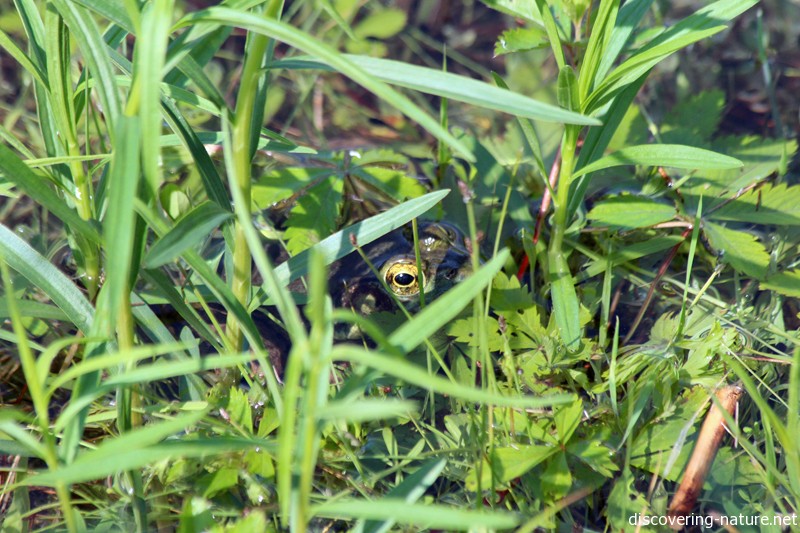
Feeling watched? The fields around the pond were filled with red-winged blackbirds and bobolinks. The bobolinks sang a two-note song, then a long string of gibberish that sounded exactly like R2-D2.
I haven’t tried to identify these caterpillars yet.
Near the car, Older Daughter spotted this tiny moth — and I do mean tiny!
When we got home we identified it as an eight-spotted forester moth.
The day was complete when we pulled into the driveway at home to find some great crested flycatchers. They’ve been around the yard for the last couple of days but they’re hard to get a good look at till they’re on their way out. My youngest spotted this one.
-
Celebrating Seeing
My daughters and I watched this pileated woodpecker in our back yard as we were eating lunch the other day. She captivated us for several minutes.
No sooner had she flown away than a rabbit appeared, gathering up mouthfuls of grass and leaf litter and hopping behind some trees to pad her nest. Now we know where to look for baby rabbits.
On the whole, this raised awareness of the creatures living all around us is the biggest plus of nature study. Who needs television if you have a window? Who needs computer games if you have eyes? The interest is simply there; all that’s needed is a very little effort to cultivate awareness.
It’s not always easy to be aware, though. Sometimes it brings sorrow. This year I notice several different areas around where bulldozers have cleared space for some kind of development, and every one of them will have an impact on birds or other creatures that lived in those spaces. Where will they go? And how much more space do humans need to take over, mow down, dig up?
Even something like Habitat for Humanity (which recently produced a house on an empty lot nearby) gives me pause these days. It sounds so positive. And it is positive to give someone an opportunity to help build their own home. But why take up new space to do it? Why not redesign an existing building standing empty? Every city has more than enough houses already, more than enough retail buildings and factory spaces. Why not use and re-use these spaces, rather than relentlessly sprawling outward like some seeping toxic spill?
Oh well… enough of the lament. Suffice it to say that I wish we gave more thought such matters before mowing down the bushes and trees to construct new buildings. Awareness — the ability simply to pay attention to what’s around you, wherever you are — is where an environmental ethic begins. Not legislation or speech-making. Opened eyes.
Speaking of which, I have seen many interesting sights of late that I haven’t recorded here, and what follows will be a long column of wonders.
Starting with an oven bird! I’ve heard these leaf-like thrushes many times calling from the forest floor, but never have I been fortunate enough to actually see one till this past weekend, on an early morning walk.
He was having a territorial squabble with another one nearby. The woods were full of them! Here, he’s standing on the ruin of an old nesting box.
At a nearby pond, we’ve seen the first of the green herons…
We’ve seen geese nesting…
…and geese newly hatched.
As I stood watching, I noticed movement from one grass tussock to the next. Meadow mice were darting like lightning from hole to hole, right out in the marsh. They’re the color of dust, but otherwise they remind me a lot of hamsters.
Water snakes abounded. None of them looked big enough to eat a mouse, but the frogs and wogs must be on the run.
I think this tiny butterfly is a silvery blue. Its wings are only about a centimeter wide. The meadow was studded with them; I also saw one bright orange butterfly too elusive to photograph.
The chipmunks are coming out of hiding — well, they’re awake. Some are still hiding.

Find that chipmunk Others look like woodland mariners sailing deadwood ships.
Happily, my daughter and I saw our first rose-breasted grosbeaks the other morning!

Mr Grosbeak 
Mrs Grosbeak There were other birds chorusing all around, including song sparrows…
…and yellow warblers.
It’s not every day that you get tracked by police while bird watching, but it happened the morning we saw these warblers. My daughter turned around, gasped, and said, “A police car!” We saw an officer circling our parked car and hurried back, fearing we’d broken some parking rule. “Oh, I was going to have her track you,” he greeted us, emerging from behind the car with a large police dog. Turns out he just saw our car and decided to take the opportunity to do some training!
There are several nests we’ve been keeping an eye on. We were thrilled to discover a red-tailed hawk nest in a spot we pass often, but it’s not terribly photographable. Still, as the nestlings grow and begin flappercizing, maybe we’ll get some better views (and pictures).
The other day, we were looking at a red-winged blackbird atop this snag when we noticed a tree swallow in a nest cavity beneath him.
Last but not least, the chickadees must have a few nestlings in this nest box outside our front window, because the parent birds have been active, flying to and fro and apparently feeding young.
It’s a great time of year for being outside. Here in the northeast the sense of release from the grip of winter seems so strong and so welcome.
Even our domestic animals like to get out and smell the flowers!

Whisper -
A few more spring sights
Here are a few more photos taken on our walk yesterday.

These guys remind me of those two old men in the balcony on “The Muppet Show.” 
A tadpole soaking up the sun. It never moved in the ten minutes I was there. 
Salamanders mating. 
Good day, Mr. Frog! 
Power-lounging squirrel. The squirrels are going to be bummed when I put the birdbath back on this base! Not captured on film were the three kingfishers flying and rattling vocally over the pond. I’m not sure if it was courtship behavior or territorial behavior, but they weren’t fishing, and they were pretty indifferent to the various humans around the edges of the pond. Swallows were diving and circling. At one point a Cooper’s hawk flew over, making a speedy path toward a racket of small birds beyond the pond.
One young man was playing his guitar on the boardwalk — adding his song to the spring peepers, honking geese and rattling kingfishers. That’s not something you can do with a piano, more’s the pity. It was nice — a human sound that blended well with all the natural sounds.
-
Sapsucker Heron


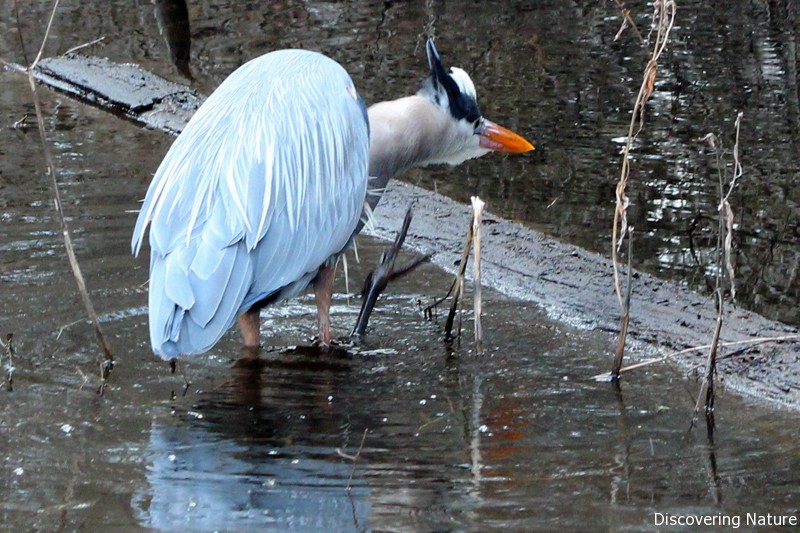 We saw that the male heron had made an appearance on the nest cam a few days ago, and when we walked around the pond at Sapsucker Woods we figured this was him. He was fishing in an alcove and we were quite close. I got some pics of him with one of the unfortunate fish he caught, but none of them are stellar.
We saw that the male heron had made an appearance on the nest cam a few days ago, and when we walked around the pond at Sapsucker Woods we figured this was him. He was fishing in an alcove and we were quite close. I got some pics of him with one of the unfortunate fish he caught, but none of them are stellar.It was kind of a man and wife who were watching him to invite the girls and me in to take their spot so that we could see the heron doing his patient, alert work. We passed on the favor to the next walkers who appeared.
-
Spring Preserve
-
Recent Sights
Mostly our recent walk at a wetland was about water birds and evidence of creatures not seen. Like this beaver mark from last year — freshly chewed this year.
Or these pileated woodpecker excavations at the edge of the parking area. Wouldn’t it be great to come upon the woodpecker at work?
In the raptor category, we’ve seen a pair of American kestrels in the same field for several weeks running. One of these days I’ll get a good picture!
My daughter and I saw this hawk capture a mouse as we were driving. I pulled over and she was able to get a nice picture — not nice for the mouse, though.
In the back yard we’ve enjoyed seeing the squirrels. Mostly they feast on maple buds, but once in awhile they get a piece of stale bread. This fellow is on the base of the bird bath, where he at least enjoys the privilege of eating NEAR the bird feeder — though he’s continually foiled in efforts to get INTO it.
-
Signs of Spring
We still haven’t seen our first robin yet, though my in-laws have seen several around their house. Today we ventured out for a very muddy walk on a sunny day, and though we saw nary a robin, we saw — and heard — other birds testifying to the inevitability of the changing season.
It was in the 30’s, and there was some sap snow in the afternoon. But its days are numbered.
-
First Birdsong
We seized upon the first sunshine in what seems like ages to go for a walk this morning. As far as sights go, it was mostly about textures and colors in little patches here and there.

These lichens seem to be doing their best to hurry spring along, stretching out toward the sun. 
It’s amazing, the variety of textures growing on this one furry tree foot. Here’s a close-up of the same tree:
There were other small wonders, like this tattooed rock…
or this woodpecker hole (I heard the pileated laughing in the distance)…
or this fallen tree. When I stop and study all the varieties growing here I wonder what it would be like to be small enough to live among them. It’s kind of strange thought, but there it is. There just seems to be such diverse vegetation in such a small area. (The pic will enlarge if you click on it.)
The vernal pool was still iced over and had a layer of snow over it, but in the deeper pond we did actually see a salamander or two. I didn’t envy them.
No beavers, though the lodge is safe and sound. No muskrats. A few deer. Two accipiters; one redtail sailed over. We heard cardinals doing warm-ups, and chickadees singing their spring love songs. And at the pond we heard what I think was a song sparrow singing like he meant business. I didn’t see him, but his song cheered me. It may not sound like much, but the first song of spring means a lot to a color-deprived Northeasterner like myself.
We headed for home after that, assured that all is progressing toward the warmth and color and wakefulness of spring. Just a short wait now.

I played with some of the artistic filters on this pic.

